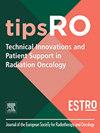Incidental dose to internal mammary nodes in post-operative radiation therapy for breast cancer
IF 2.8
Q1 Nursing
Technical Innovations and Patient Support in Radiation Oncology
Pub Date : 2025-09-27
DOI:10.1016/j.tipsro.2025.100346
引用次数: 0
Abstract
Aims
The incidental dose to the internal mammary nodes (IMN) is understudied in patients treated with newer radiation therapy (RT) techniques. The aim of this study was to quantify the incidental IMN dose in a series of breast cancer (BC) patients receiving post-operative RT to the chest wall/breast and regional nodes (level III-IV).
Methods
We retrospectively analyzed data from 95 high-risk BC patients treated between 2015 and 2022. Patients received RT (50 Gy/25fr or 40.05 Gy/15fr) to the breast/chest wall and nodal levels III-IV after mastectomy or breast conserving surgery (BCS). Exclusion criteria were IMN irradiation and pre-operative systemic therapy. One radiation oncologist contoured the CTV_IMN according to ESTRO guidelines and divided it into four sub-regions based on intercostal spaces (ICS): IMNupper, ICS1, ICS2, ICS3. Dosimetric parameters collected were Dmean, V90, V95, D90, and D95. The Dmean was correlated to tumor laterality and location, type of surgery and reconstruction, RT technique (3D-CRT, IMRT, helical RT) and boost.
Results
Mean Dmean to IMN was 71.4 % (range 19.6–118.6) of the prescription dose. Among sub-region, ICS2 and ICS3 received significantly higher doses than ICS1 and IMN upper (p = 0.04). V90 of over 90 % was achieved in only 4/95 patients, 3 were treated with helical RT, and the other with IMRT. The mean V95 and V90 were 15.4 % and 26.2 % respectively. Univariate analysis showed that mastectomy (p = 0.002), omission of boost (p = 0.001), and helical RT (p < 0.0001) were associated with significantly higher IMN Dmean. No significant correlation emerged with laterality, tumor location and type of reconstruction.
Conclusions
In our series, incidental IMN doses were highest after mastectomy and with helical RT delivery, possibly due to more medial margin in chest wall delineation and the helical dose distribution. Nevertheless, incidental doses to the IMN were below recommended doses, thus highlighting the need for IMN contouring when identified as targets.
乳腺癌术后放疗对乳腺内淋巴结的附带剂量
目的对接受新型放射治疗(RT)的患者的乳腺内淋巴结(IMN)的偶发剂量进行了研究。本研究的目的是量化一系列乳腺癌(BC)患者术后接受胸壁/乳房和区域淋巴结RT (III-IV级)的偶发IMN剂量。方法回顾性分析2015年至2022年间接受治疗的95例高危BC患者的资料。患者在乳房切除术或保乳手术(BCS)后接受放射治疗(50 Gy/25fr或40.05 Gy/15fr)至乳腺/胸壁和淋巴结III-IV级。排除标准为IMN照射和术前全身治疗。一位放射肿瘤学家根据ESTRO指南绘制了CTV_IMN的轮廓,并根据肋间隙(ICS)将其分为四个子区域:IMNupper, ICS1, ICS2, ICS3。收集的剂量学参数为Dmean、V90、V95、D90和D95。Dmean与肿瘤的侧边和位置、手术类型和重建、RT技术(3D-CRT、IMRT、螺旋RT)和boost相关。结果该药对IMN的平均值为处方剂量的71.4%(范围19.6 ~ 118.6)。在次区域中,ICS2和ICS3的剂量显著高于ICS1和IMN上限(p = 0.04)。只有4/95例患者的V90达到90%以上,其中3例采用螺旋RT, 1例采用IMRT。V95和V90的平均值分别为15.4%和26.2%。单因素分析显示,乳房切除术(p = 0.002)、未行助推术(p = 0.001)和螺旋RT (p < 0.0001)与较高的IMN Dmean相关。与侧位、肿瘤位置和重建类型无显著相关性。结论在我们的研究中,乳房切除术和螺旋放射治疗后的偶发放射剂量最高,这可能是由于胸壁描画更内侧边缘和螺旋剂量分布所致。然而,IMN的偶然剂量低于建议剂量,因此,当确定为目标时,强调需要对IMN进行轮廓。
本文章由计算机程序翻译,如有差异,请以英文原文为准。
求助全文
约1分钟内获得全文
求助全文
来源期刊

Technical Innovations and Patient Support in Radiation Oncology
Nursing-Oncology (nursing)
CiteScore
4.10
自引率
0.00%
发文量
48
审稿时长
67 days
 求助内容:
求助内容: 应助结果提醒方式:
应助结果提醒方式:


